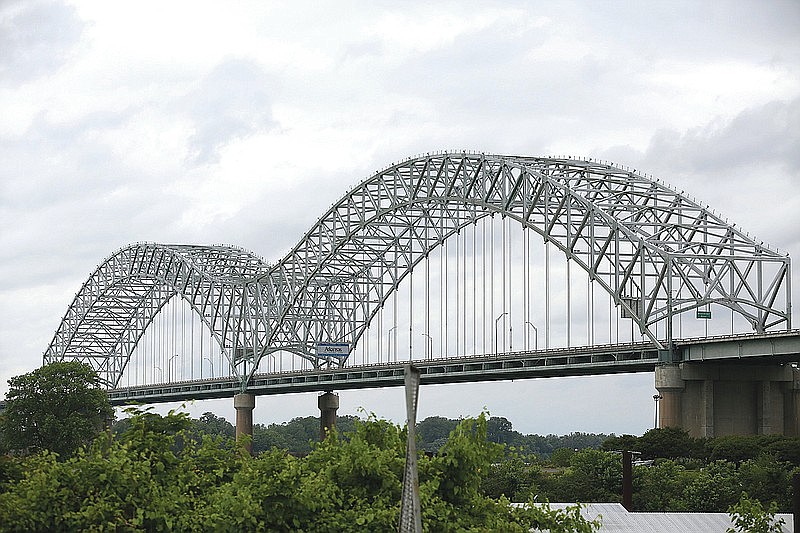Seven of the eight permanent steel plates are in place to fix a cracked beam on the Interstate 40 bridge between Memphis and West Memphis, the Tennessee Department of Transportation said Monday.
"The drilling and bolting of these plates are ongoing," according to an update late Monday afternoon from Nichole Lawrence, the agency's community relations officer for western Tennessee. "Fabrication of other miscellaneous steel components continues, and delivery is expected this week."
In a tweet on Monday morning, Lawrence said the last plate weighs 6,000 pounds. The tweet included video of the last plate being lifted by a crane on the bridge. A large sign reading "Welcome to Arkansas" hung overhead.
"The eighth structural plate goes in after the fracture is partially realigned," said Brandon Akins, operations district engineer for the agency's Region 4. "Several of the plates that are currently installed still have drilling/bolting/torquing to do. We still have a minimum of four to five shifts just to finish drilling/bolting/torquing the plates we currently have in place."
Akins said the plates average 30 feet long, and the heaviest one is about 12,000 pounds.
Four of the eight steel plates were in place on Friday.
"In-depth field inspections of the bridge are complete," according to Monday's update. "We are now awaiting the final report."
The I-40 bridge over the Mississippi River has been closed since May 11, when a crack was found in a beam during a routine inspection. Completed in 1973, the bridge is officially known as the Hernando de Soto Bridge, or "the new bridge."
6-28-2021
— Nichole Lawrence (@NicLawrenceTDOT) June 28, 2021
The 8th structural steel plate being moved into position. Weighs in at approx 6K lbs and approx 30 feet long. #memphis #i40riverbridge pic.twitter.com/Zo0k8FVVEz
Traffic is being routed to the Interstate 55 bridge, 3 miles to the south. Completed in 1949, the I-55 bridge is also known as the Memphis and Arkansas Bridge, or to Memphians as just "the old bridge."
The fractured section of the I-40 bridge's tie girder was removed June 21.
The following day, Lawrence tweeted: "1.2 MILLION pounds of pressure applied to the post tension rods to be able to install the new plates. This process is estimated to take 10-15 days."
Transportation officials haven't provided a concrete timeline, but they estimate completion of the bridge repairs could take until the end of July. Work to repair the bridge has been going on 24 hours a day, seven days a week.
The crack on the Hernando de Soto Bridge, a tied-arch span, was found on a steel beam that connected chords to the arch. When the beam cracked, the load that was once carried by the beam shifted to other parts of the bridge.
The Tennessee Transportation Department oversees repairs of the shared bridge, while the Arkansas department is responsible for bridge inspections. Kiewit Infrastructure Group was contracted for the repairs.
By removing a small section of the cracked beam, the Tennessee transportation department is leaving the bulk of the beam in place.
"This design will require less fabrication time and offers the advantage of getting the bridge open to traffic two to three weeks sooner than replacing the damaged steel box assembly in its entirety," according to the agency's website.
Randy Ort, deputy director of the Arkansas Department of Transportation, said there was no significant news to add from the agency's perspective on Monday.
The crack was discovered May 11, but a photo from 2019, confirmed by transportation officials to be authentic, shows the crack has been around for potentially years. Another photo, currently being reviewed by state and federal officials, appears to show a crack as far back as 2016.
The discovery led the Arkansas department to fire the inspection team leader for missing the crack on previous inspections.

